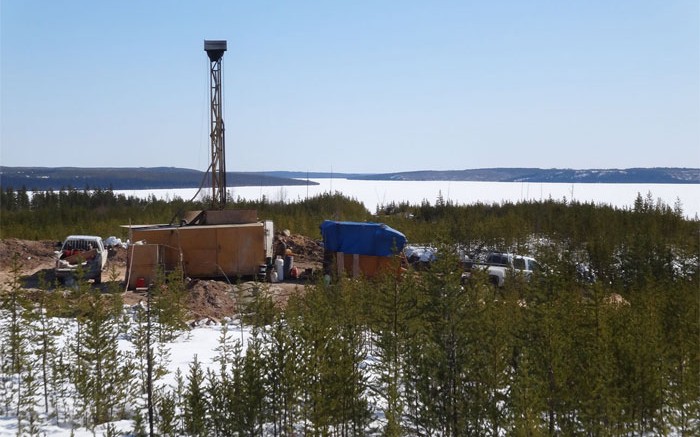VANCOUVER — After almost ending up a neglected project on Denison Mines’ (TSX: DML; NYSE-MKT: DNN) shelf, a 50% stake in the Patterson Lake South (PLS) uranium project has sparked a $170-million takeover.
Last year PLS was a joint venture between Fission Energy and Alpha Minerals (TSXV: AMW; US-OTC: ESOFF). In January Denison struck a deal to acquire Fission Energy for its stake in another Athabasca basin uranium project: Waterbury Lake. Fission’s 50% stake in the early stage PLS project was lumped into the deal, but it would have been a tiny fraction of the $70-million price tag.
In a stroke of luck and timing, Fission hit into high-grade uranium at PLS just before signing the Denison deal. The takeover was quickly rejigged to put the southern Athabasca basin project into a new vehicle called Fission Uranium (TSXV: FCU; US-OTC: FCUUF), and now, eight months later, Fission has offered to take out its PLS partner Alpha Minerals in a deal worth $170 million.
Fission informally offered 5.3 Fission shares for each Alpha share held, which represented a share price of $7.26 on Aug. 23. The deal would have let Alpha appoint two members to Fission’s board of directors.
Whatever the numbers, Alpha president and CEO Ben Ainsworth says his team needed more time to contemplate the proposal, which expired in just 48 hours.
“It’s not unusual for people to do that if they’re trying to push things along a bit faster,” Ainsworth says. “And we did immediately go into a huddle with all of our directors that resulted in the letter I sent to [Fission president and chief operating officer] Ross McElroy.”
The letter, which declined the offer, was by no means the first time the partners have discussed consolidation. Both companies acknowledge they have been talking about it for months — “ever since the discovery,” according to Ainsworth.
For a time, though, they held off because having two owners provided PLS with some protection from predatory takeover offers, based on the idea that it is harder for an interested party to seal two deals rather than one.
“One of the things you want to do is build as many pounds as possible before you expose yourself to a takeout, and one way of doing that is keeping it separate,” Ainsworth says.
Fission made similar comments in its news release about the offer, though the company says the benefits of the built-in poison pill have faded.
“Fission believes it has outlived its usefulness, and, given the strength of the results, actually leaves both parties exposed to not trading with the proper premium, given that neither company has control of PLS,” the company said. “Further, while Fission believes it is the only logical buyer for Alpha, the combined company could represent an attractive takeover target for a buyer seeking to acquire 100% control of the PLS project.”
Ainsworth acknowledges that merging with Fission is somewhat of an inevitability for Alpha. The question is when.
“Right now we’re in the middle of a significant drill program at PLS, and while we do report the handheld total counts gamma radiation from the drill core, there’s nothing like seeing the assays at the end of the day,” Ainsworth says. “That’s why some say we should wait until the end of the drill program [to talk about a takeover]. But that’s evidently not the feeling of Fission at the moment.”
Ainsworth is optimistic that Alpha and Fission will continue to talk.
Fission, however, is less patient: Its news release makes clear that Fission thinks Ainsworth’s letter is an insufficient response to its offer, and that it is more than willing to approach Alpha’s shareholders on its own terms.
“Fission’s proposal expired . . . on Aug. 25, and to this point Alpha has not engaged with the company in meaningful discussions,” Fission said in the release. “Fission wants Alpha’s shareholders to be aware that the proposal was made. If Alpha continues to refuse to engage with Fission on the proposal, Fission will consider making an offer directly to Alpha’s shareholders.”
Fission and Alpha (then called ESO Uranium) inked a joint-venture deal for PLS in early 2008. At the time the property’s only attribute was a set of high radon and radiometric readings from a 1977 exploration program. The partners slowly mapped and surveyed the site, leading to the discovery of a high-grade uranium boulder train in mid-2011.
In the fall of 2012 the partners were ready to drill. The first few holes returned lacklustre, low-grade intercepts, such as 0.085% uranium oxide (U3O8) over 0.6 metre. That all changed with the final four holes of the program, which hit into substantial uranium mineralization. Hole 12-24, for example, cut 12.5 metres of 2.49% U3O8.
The partners immediately embarked on a US$6.9-million, 11,000-metre winter drill program. Best results from that program to date include 49.5 metres of 6.26% U3O8, 52 metres of 6.57% U3O8 and 34 metres of 4.92% U3O8.
These results come from four mineralized zones where Fission’s drills — Fission is the operator at PLS — have defined, along a trend that runs for more than a kilometre. Mineralization at PLS mainly occurs between 120 and 170 metres depth.
The share prices for both Fission and Alpha have skyrocketed on the PLS discovery. Fission listed at the end of April at 57¢. Within a month Fission shares were worth almost 80¢, and today they trade above $1.40. On news of its ersatz takeover offer for Alpha, Fission’s shares gained 4¢ to close at $1.42. Fission has 150 million shares outstanding.
Alpha was trading below 40¢ when Fission’s drill hit high grade at PLS in late 2012. Within a month Alpha shares had climbed above $2. Since then a steady ascent has lifted its share price to almost $7. On news of the Fission offer, Alpha added 40¢ to close at $7.25. Alpha has 23.5 million shares outstanding.


Be the first to comment on "Alpha rebuffs Fission’s $170M offer"